Even the coolest of cucumbers feels stressed out from time to time. The demands and hectic pace of our always-on world, juggling work and family responsibilities, and unexpected shocks can all make it difficult to relax.
Stress affects your body in several ways. It can impact your breathing, blood pressure, and of course, your sleep. Your heart rate also increases when you’re stressed out, which is why Oura members can monitor their stress levels by checking their Heart Rate Variability (HRV) in the Oura App. Your HRV can provide critical insights into your stress responses, and tracking it can help you take steps to improve your HRV and manage stress.
How Stress Affects Your Breathing
“When you experience stress, whether it’s a difficult situation professionally or personally, your fight-or-flight response kicks into gear,” says Rebecca Robbins, PhD, a sleep scientist and Oura advisor. “When initiated, this system can take over and cause your heart rate and breathing rate to increase.”
While useful in certain circumstances, taking fast, shallow breaths when you’re stressed is not the most helpful approach. In fact, if you allow your fight-or-flight response to get out of control, you’re more likely to create a “negative feedback loop,” where you continue to feel short of breath and anxious, perpetuating the cycle of short breathing and feelings of stress and anxiety, Robbins explains.
Take a Breath
You’ve probably heard someone tell you to “take a deep breath” when you’re stressed out. Turns out, this deceptively simple action is surprisingly powerful — multiple studies have shown that breathing exercises are highly effective for reducing stress and restoring overall wellness.
“Deep breathing, particularly when we are faced with stressful experiences, can help reverse our fight-of-flight state,” Robbins explains. “Deep, full breaths that engage the diaphragm’s full range of motion infuse our lungs with oxygenated air, calm the fight-or-flight response, and allow us to engage in adaptive responses to the stressors we are experiencing.”
What’s more: Research shows that reducing your stress levels has multiple benefits for your overall health and is vital for getting a good night’s sleep.
Oura members can access guided audio breathwork exercises in the Explore content of the Oura App. Plus, after each session, members receive a Wellness Session Biofeedback report detailing how their body responded to the session. Those who tagged breathwork saw an 8% decrease in awake time during their sleep period!
If you’re not an Oura member yet or just need a quick pick-me-up, this article will walk you through ten deep breathing exercises that are proven to bring near-instant stress relief.
RELATED: How Stress Affects Your Sleep
1. Pursed-Lip Breathing
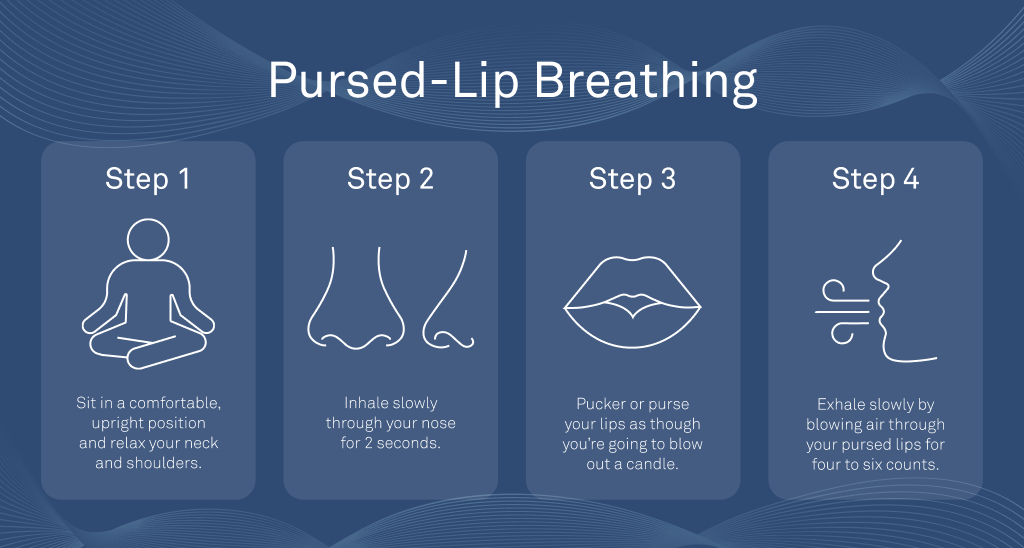
Clinical research has found pursed-lip breathing to be an “excellent tool for relaxation.” This simple breathing technique can even provide relief from the symptoms of COPD (chronic respiratory conditions), such as shortness of breath.
Here’s how to do it:
- Sit in a comfortable, upright position and relax your neck and shoulders. Become aware of any tight muscles around your face and release your tongue from the roof of your mouth.
- Keeping your mouth and eyes closed, inhale slowly through your nose for two seconds.
- Pucker or purse your lips as though you’re going to blow out a candle.
- Exhale slowly by blowing air through your pursed lips for four to six counts (without forcing the air out).
- Repeat for five to ten cycles of breath.
2. Yogic Deep Breathing
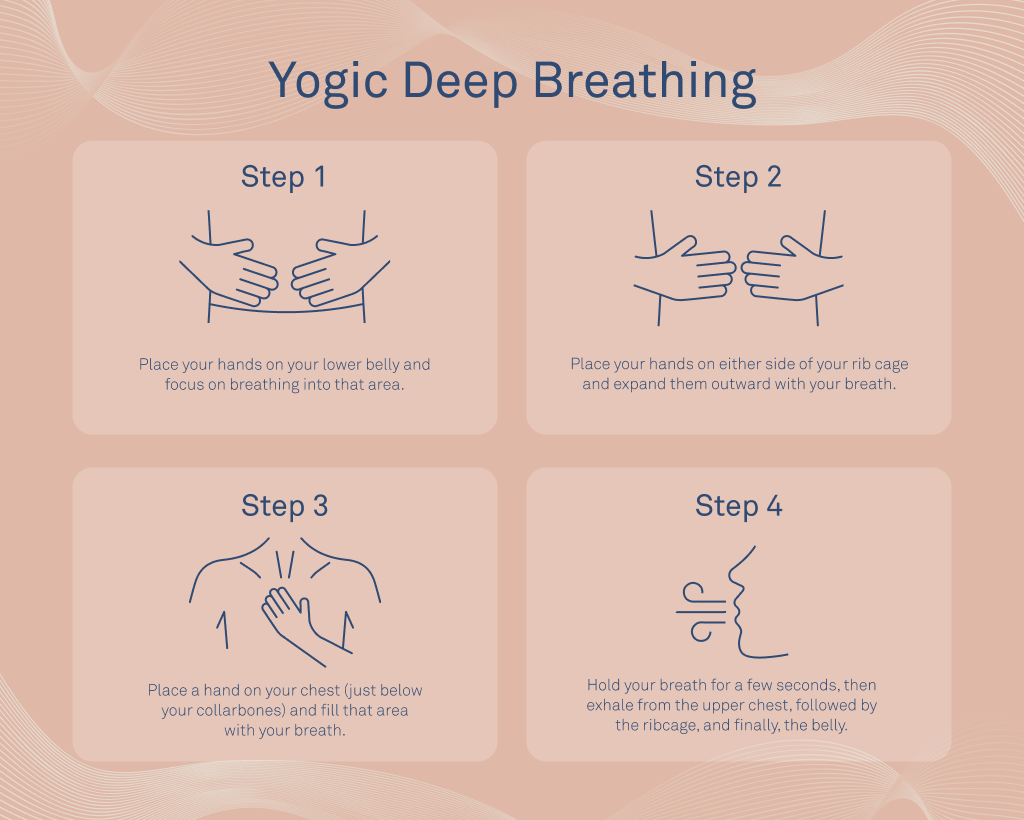
Yogic breathing is a three-part technique that involves breathing with a focus on the diaphragm, ribcage, and upper chest. Psychologist Dr. Chloe Carmichael, PhD, recommends this technique to cultivate mindfulness.
It can take a few goes to get the hang of it, so when you start, it’s best to use your hands to feel which parts of your body are moving as you breathe.
- Place your hands on your lower belly and focus on breathing into that area.
- Place your hands on either side of your rib cage and expand them outward with your breath.
- Place a hand on your chest (just below your collarbones) and fill that area with your breath.
Try to make each step last for a count of two. As you practice, you’ll probably find your breath naturally lengthens.
Hold your breath for a few seconds or as long as you can, then reverse the process by exhaling from the upper chest first, followed by the ribcage, then finishing with the belly.
Repeat for eight to ten cycles.
3. Alternate Nostril Breathing
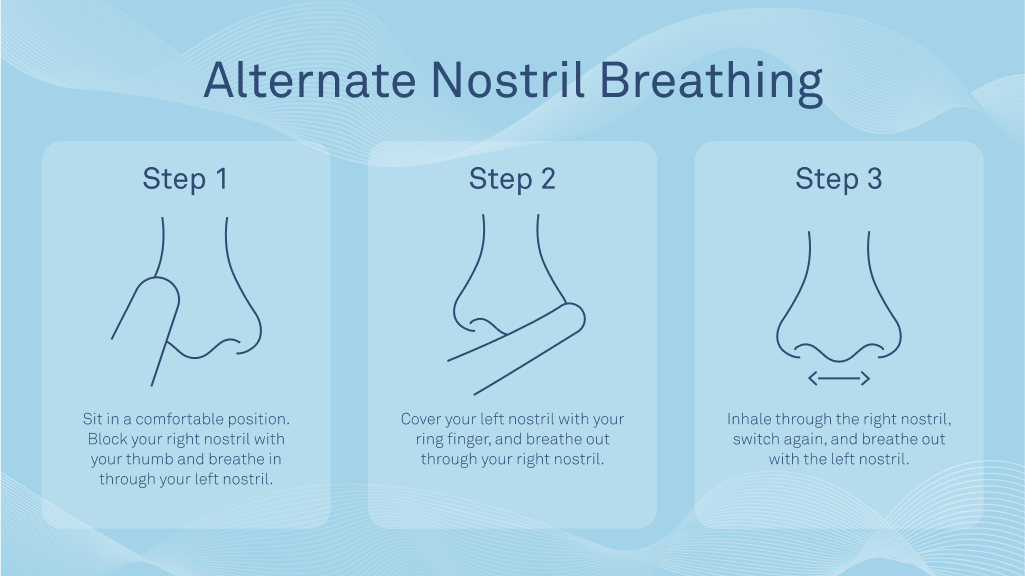
This technique — known as Nadi Shodhana in Sanskrit — is one of several yogic breathing techniques (or Pranayama) that studies have shown may help to reduce stress.
To practice alternate nostril breathing:
- Sit in a comfortable position. Start by blocking your right nostril with your thumb and breathing in through your left nostril.
- At the top of the inhale, cover your left nostril with your ring finger, and breathe out through your right nostril.
- Inhale through the right nostril, switch again, and breathe out with the left nostril.
One full cycle of Nadi Shodhana is two inhales and two exhales, so one round ends when you exhale out of the left nostril.
Practice at least four full rounds whenever you need to slow down and relax.
4. Box Breathing
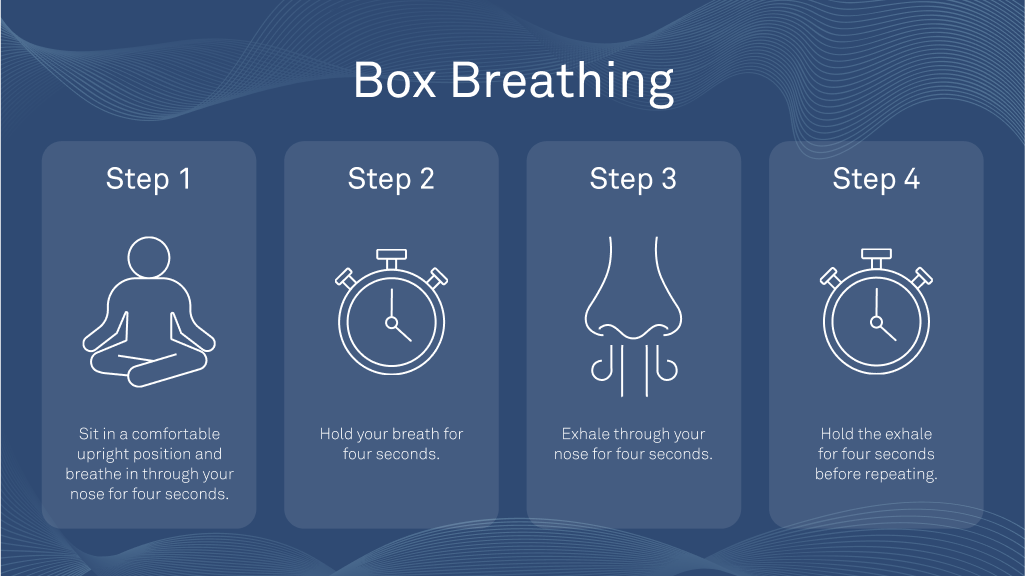
Also known as paced breathing, one study found that this type of breathing increases your awareness of your inner experiences, which can help you respond more mindfully in stressful situations.
Here’s how to do box breathing:
- Sit in a comfortable upright position.
- Breathe in through your nose for four seconds.
- Hold your breath for four seconds.
- Exhale through your nose for four seconds
- Hold the exhale for four seconds before repeating.
- Continue for up to 5 minutes.
5. Long Exhale Breathing
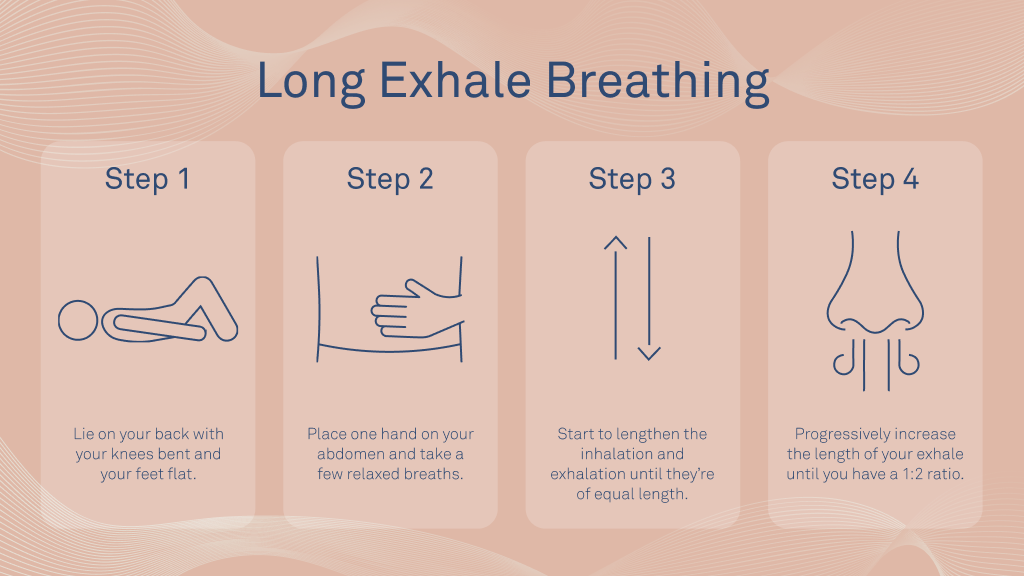
Research indicates that slow breathing regulates the nervous system, which is responsible for activating and deactivating your stress response (known as “fight or flight”) and relaxation response (aka “rest and digest”). Long exhale breathing is a relaxing breath that harnesses this mechanism.
To practice long exhale breathing:
- Lie on your back with your knees bent and your feet flat.
- Place one hand on your abdomen and take a few relaxed breaths.
- Start to lengthen the inhalation and exhalation until they’re of equal length.
- Then, progressively increase the length of your exhale until you have a 1:2 ratio.
- Continue for five to ten minutes.
6. Belly Breathing
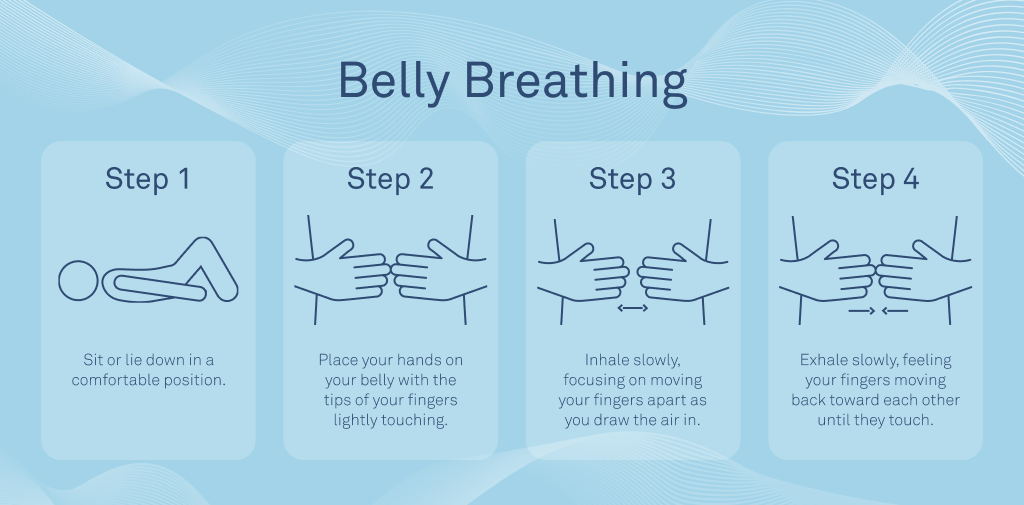
Belly breathing, also known as abdominal breathing or diaphragmatic breathing, engages your stomach muscles, diaphragm, and lungs. A 2017 study found that diaphragmatic breathing reduces the stress hormone cortisol, helping you feel more relaxed.
Belly breathing requires relaxing your diaphragm and abdominal muscles, which allows your lower abdomen to move with the breath.
To practice belly breathing:
- Sit or lie down in a comfortable position.
- Place your hands on your belly with the tips of your fingers lightly touching.
- Inhale slowly, focusing on moving your fingers apart as you draw the air in.
- Exhale slowly, feeling your fingers moving back toward each other until they touch.
- Repeat for at least ten breath cycles.
7. Lion’s Breath
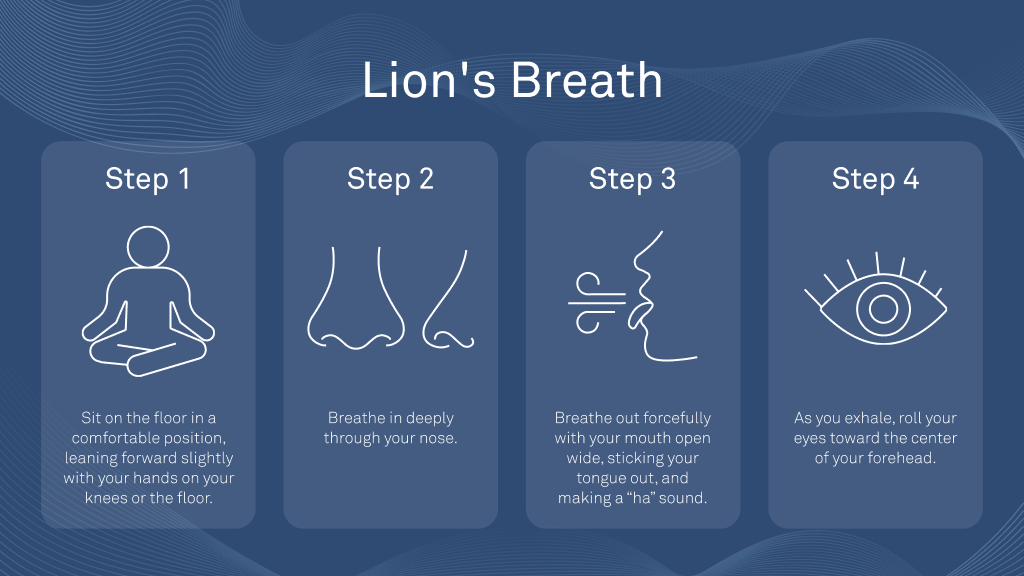
This technique, called Simhasana in Sanskrit, uses breathing and facial stretches to relieve stress and tension. It involves sitting and “roaring” like a lion — hence the name.
Patrick McKeown, international breathing and sleep expert and author of The Oxygen Advantage, says that lion’s breath can help you release pent-up emotions that might be causing stress.
To do it:
- Sit on the floor in a comfortable position, leaning forward slightly with your hands on your knees or the floor.
- Breathe in deeply through your nose.
- Breathe out forcefully with your mouth open wide, sticking your tongue out, and making a “ha” sound.
- As you exhale, roll your eyes toward the center of your forehead.
- Repeat the exercise three times.
8. Mindfulness Breathing
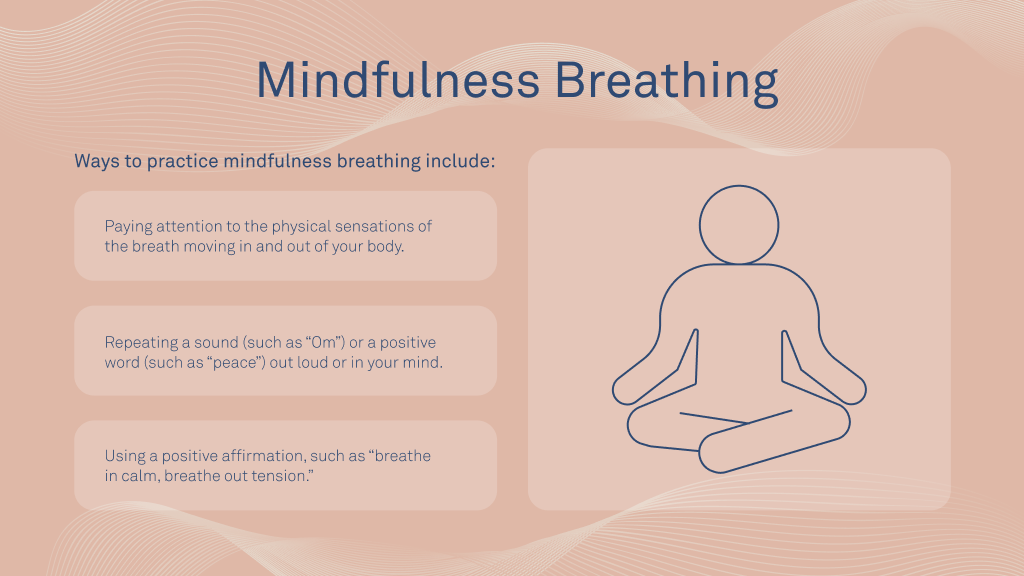
“Mindfulness” simply means being aware of the present moment — and research indicates that it helps improve emotional regulation and general well-being.
With mindful breathing, the focus of your attention is on your breath, which automatically brings you into the present moment and can even prepare your mind for meditation.
There are many ways to practice mindfulness breathing, including:
- Paying attention to the physical sensations of the breath moving in and out of your body.
- Repeating a sound (such as “Om”) or a positive word (such as “peace”) out loud or in your mind.
- Using a positive affirmation, such as “breathe in calm, breathe out tension.”
If you notice your mind drifting, don’t beat yourself up — it’s normal. Just gently return your attention to the present.
9. Resonance Frequency Breathing
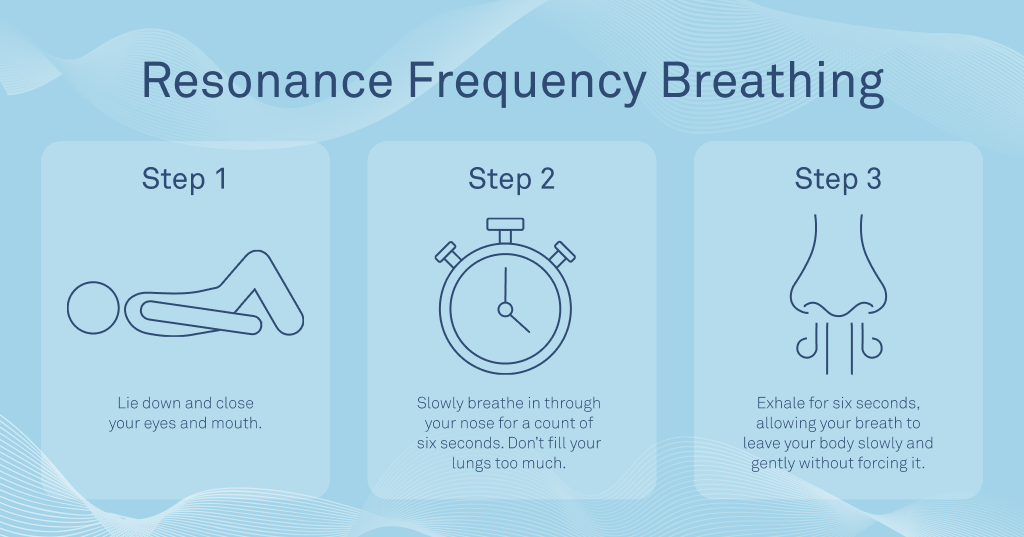
A 2022 study found that a regular resonance frequency breathing practice improves HRV, which helps to alleviate symptoms of stress.
The idea is to slow your breathing down to a rate of between three to seven breaths per minute, helping your body and nervous system enter a relaxed state.
To practice resonance breathing:
- Lie down and close your eyes and mouth.
- Slowly breathe in through your nose for a count of six seconds. Don’t fill your lungs too much.
- Exhale for six seconds, allowing your breath to leave your body slowly and gently without forcing it.
- Continue for up to 10 minutes.
- Take a few additional minutes to be still and focus on how your body feels.
10. Victorious Breathing
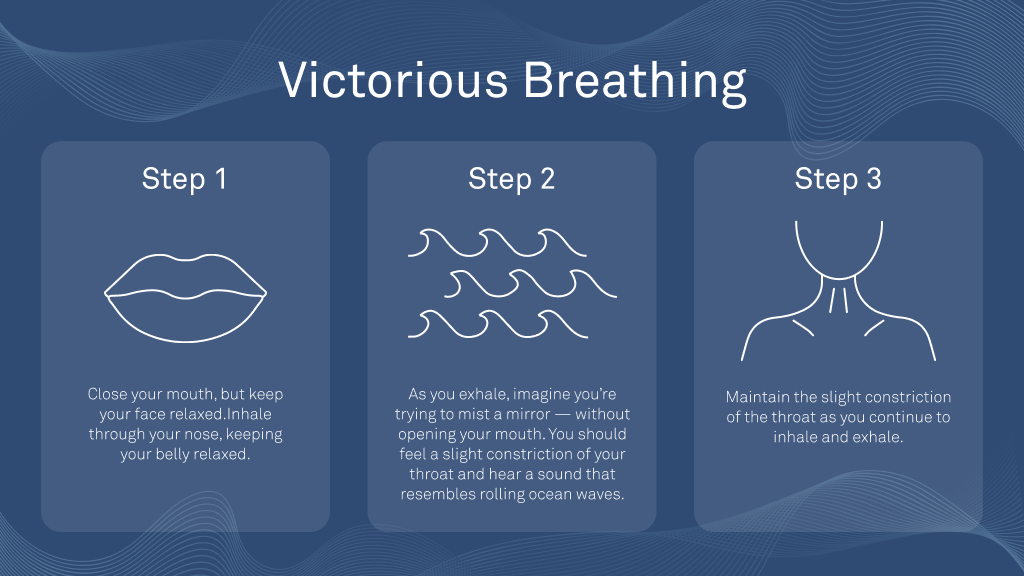
Victorious breathing, known as Ujjayi in Sanskrit, is a calming breathing technique that studies show can relieve anxiety and improve attention and concentration.
It requires combining a relaxed belly breath with a slight constriction of the throat.
To do it:
- Close your mouth, but keep your face relaxed.
- Inhale through your nose, keeping your belly relaxed.
- As you exhale, imagine you’re trying to mist a mirror — without opening your mouth. You should feel a slight constriction of your throat and hear a sound that resembles rolling ocean waves.
- Maintain the slight constriction of the throat as you continue to inhale and exhale.
- Repeat until you feel relaxed.
Use these breathing techniques to stay cool in a crisis
These ten breathing exercises and other relaxation techniques can help you improve your HRV and stay cool, calm, and collected in the face of stressful situations.
Oura Ring measures members’ HRV every five minutes during the night, providing accurate and detailed insights into how your body is responding to stress and how well it’s preparing for the next day.
Researchers at the University of Helsinki investigated whether Oura Ring HRV could predict anxiety and depression among members. Discover the surprising results of the study in this article.











